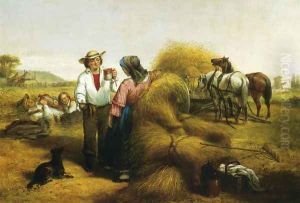James Cafferty Paintings
James Cafferty was an American painter born in 1819, notable for his contributions to the Hudson River School, a mid-19th century art movement that was characterized by its realistic and detailed portrayals of American landscapes. Despite not being as widely recognized as some of his contemporaries, Cafferty's work played a significant role in the development and recognition of American landscape painting during a time when the young nation was seeking a cultural identity distinct from European influences.
Cafferty's life was one deeply intertwined with the burgeoning art scene of New York. Growing up in a period of rapid urbanization and change, he was drawn to the untouched landscapes of the American wilderness, seeking to capture its sublime beauty and ruggedness. His paintings often depicted the Hudson River Valley, the Catskills, and other natural locales, imbued with a sense of tranquility and the sublime, reflecting the Romantic era's fascination with nature's power and majesty.
Throughout his career, James Cafferty was known for his meticulous attention to detail and his ability to convey the atmospheric effects of light and shadow, a hallmark of the Hudson River School. Despite his talent, Cafferty's work was often overshadowed by the likes of Thomas Cole, Frederic Edwin Church, and Albert Bierstadt, whose grandiose landscapes defined the era's art. Nevertheless, Cafferty's paintings remain an important part of the American art historical canon, offering insight into the nation's evolving relationship with its natural landscapes.
James Cafferty's life was cut short when he died in 1869, but his contributions to American art did not go unnoticed. His works are preserved in several museums and collections, where they continue to be studied and admired for their beauty and historical significance. Through his paintings, Cafferty not only captured the spirit of an era but also contributed to the growing appreciation for America's natural splendor and the need for its preservation.
